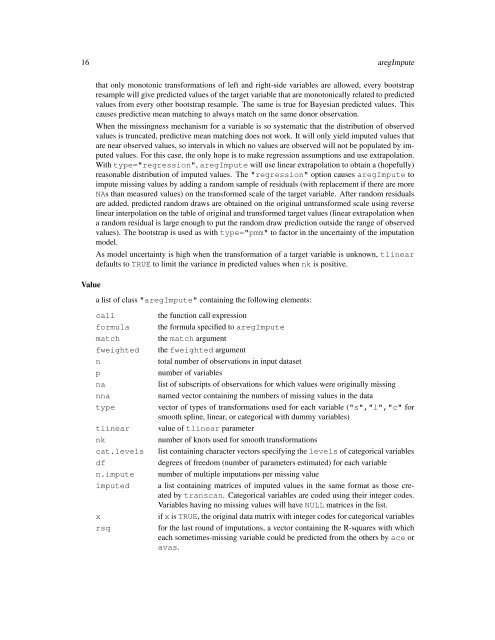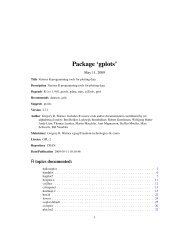- Page 1 and 2: Package ‘Hmisc’ April 29, 2009
- Page 3 and 4: R topics documented: 3 HmiscOvervie
- Page 5 and 6: abs.error.pred 5 abs.error.pred Ind
- Page 7 and 8: approxExtrap 7 Examples all.is.nume
- Page 9 and 10: areg 9 y xtype ytype nk B na.rm tol
- Page 11 and 12: areg 11 ## Not run: # Examine overf
- Page 13 and 14: aregImpute 13 Usage A print method
- Page 15: aregImpute 15 burnin pr plotTrans t
- Page 19 and 20: aregImpute 19 # plot(1:100, f$imput
- Page 21 and 22: inconf 21 method include.x include.
- Page 23 and 24: iVar 23 spearman2(formula, data=NUL
- Page 25 and 26: ootkm 25 bootkm Bootstrap Kaplan-Me
- Page 27 and 28: power 27 bsamsize(p1, p2, fraction=
- Page 29 and 30: pplot 29 Description Producess side
- Page 31 and 32: ystats 31 a missing value causes th
- Page 33 and 34: ciapower 33 Value Returns a vector
- Page 35 and 36: cnvrt.coords 35 Arguments x y input
- Page 37 and 38: combine 37 ## create a subplot with
- Page 39 and 40: contents 39 contents(object, dslabe
- Page 41 and 42: cpower 41 Details Value For handlin
- Page 43 and 44: csv.get 43 Description Makes a vect
- Page 45 and 46: curveRep 45 Value a new data frame.
- Page 47 and 48: curveRep 47 extrap pr which method
- Page 49 and 50: curveRep 49 Examples ## Not run: #
- Page 51 and 52: cut2 51 Usage cut2(x, cuts, m, g, l
- Page 53 and 54: data.frame.create.modify.check 53 S
- Page 55 and 56: data.frame.create.modify.check 55 #
- Page 57 and 58: data.frame.create.modify.check 57 #
- Page 59 and 60: data.frame.create.modify.check 59 #
- Page 61 and 62: dataRep 61 Usage variables, the per
- Page 63 and 64: describe 63 Usage deff(y, cluster)
- Page 65 and 66: describe 65 may or may not have a r
- Page 67 and 68:
describe 67 #get quantiles .05,.10,
- Page 69 and 70:
dotchart2 69 Details as.discrete co
- Page 71 and 72:
dropUnusedLevels 71 xaxis set to FA
- Page 73 and 74:
Ecdf 73 Usage Ecdf(x, ...) ## Defau
- Page 75 and 76:
Ecdf 75 Value for Ecdf.default an i
- Page 77 and 78:
equalBins 77 equalBins Multicolumn
- Page 79 and 80:
errbar 79 panel.first panel.last as
- Page 81 and 82:
event.chart 81 event.chart Flexible
- Page 83 and 84:
event.chart 83 or an S-Plus dates o
- Page 85 and 86:
event.chart 85 If "custom" is chose
- Page 87 and 88:
event.chart 87 subset.c) specified
- Page 89 and 90:
event.chart 89 Dubin, J.A., Lee, J.
- Page 91 and 92:
event.convert 91 # To produce more
- Page 93 and 94:
event.history 93 Description Usage
- Page 95 and 96:
event.history 95 the individual rig
- Page 97 and 98:
event.history 97 plot(heart.surv, y
- Page 99 and 100:
find.matches 99 ## S3 method for cl
- Page 101 and 102:
find.matches 101 # For many applica
- Page 103 and 104:
format.df 103 Value a character str
- Page 105 and 106:
format.df 105 \tabular environment
- Page 107 and 108:
gbayes 107 gbayes Gaussian Bayesian
- Page 109 and 110:
gbayes 109 sd prior pcdf delta v n1
- Page 111 and 112:
gbayes 111 stat
- Page 113 and 114:
getHdata 113 # Get the posterior de
- Page 115 and 116:
getZip 115 Examples ## Not run: get
- Page 117 and 118:
hist.data.frame 117 Author(s) Frank
- Page 119 and 120:
histbackback 119 Arguments Value x,
- Page 121 and 122:
HmiscOverview 121 ciapower cleanup.
- Page 123 and 124:
HmiscOverview 123 minor.tick mtitle
- Page 125 and 126:
HmiscOverview 125 sys tex transace
- Page 127 and 128:
hoeffd 127 Usage hoeffd(x) hoeffd(x
- Page 129 and 130:
html 129 file name of the file to c
- Page 131 and 132:
inc-dec 131 Value object ... ignore
- Page 133 and 134:
labcurve 133 To add a legend defini
- Page 135 and 136:
labcurve 135 y for putKeyEmpty and
- Page 137 and 138:
labcurve 137 lwd col. col transpare
- Page 139 and 140:
labcurve 139 Value key is called on
- Page 141 and 142:
label 141 # Use the mouse to draw a
- Page 143 and 144:
label 143 Arguments x Value self un
- Page 145 and 146:
latex 145 Details A.ttributes of th
- Page 147 and 148:
latex 147 caption=NULL, caption.lot
- Page 149 and 150:
latex 149 cgroup n.cgroup rgroup n.
- Page 151 and 152:
latex 151 booktabs table.env here l
- Page 153 and 154:
latex 153 PATH=paste(Sys.getenv("PA
- Page 155 and 156:
ldBands 155 Usage Lan. Such stoppin
- Page 157 and 158:
ldBands 157 Value A list of class "
- Page 159 and 160:
makeNstr 159 Arguments struct depth
- Page 161 and 162:
mChoice 161 Value For mApply, the r
- Page 163 and 164:
mChoice 163 table a vector (mChoice
- Page 165 and 166:
mdb.get 165 # could also do: # summ
- Page 167 and 168:
mgp.axis 167 Arguments side at see
- Page 169 and 170:
mhgr 169 Author(s) Frank E Harrell
- Page 171 and 172:
Misc 171 Author(s) Frank Harrell De
- Page 173 and 174:
Misc 173 outerText(string, y, setAs
- Page 175 and 176:
mtitle 175 set.seed(1) whichClosest
- Page 177 and 178:
na.detail.response 177 Usage na.del
- Page 179 and 180:
na.keep 179 # age=NA age!=NA sex!=N
- Page 181 and 182:
panel.bpplot 181 Examples nstr(c("a
- Page 183 and 184:
panel.bpplot 183 Author(s) Frank Ha
- Page 185 and 186:
pc1 185 See Also split Examples a
- Page 187 and 188:
plsmo 187 plsmo Plot smoothed estim
- Page 189 and 190:
plsmo 189 type pch cex font set to
- Page 191 and 192:
print.char.list 191 Value a list co
- Page 193 and 194:
print.char.matrix 193 print.char.ma
- Page 195 and 196:
ps.slide 195 Arguments x txt any ob
- Page 197 and 198:
ps.slide 197 strip.blank =TRUE, lty
- Page 199 and 200:
ps.slide 199 Value ratio lref psref
- Page 201 and 202:
corr 201 Details Certain functions
- Page 203 and 204:
corr.cens 203 Usage rcorr.cens(x, S
- Page 205 and 206:
corrp.cens 205 abline(h=.5, v=0, co
- Page 207 and 208:
cspline.eval 207 rcspline.eval Rest
- Page 209 and 210:
cspline.plot 209 nk knots show adj
- Page 211 and 212:
cspline.restate 211 after begin nbe
- Page 213 and 214:
edun 213 minfreq iterms pc pr For a
- Page 215 and 216:
equirePackage 215 Examples x
- Page 217 and 218:
eShape 217 colvar base reps times t
- Page 219 and 220:
legend 219 # d
- Page 221 and 222:
m.boot 221 rm.boot Bootstrap Repeat
- Page 223 and 224:
m.boot 223 smoother xlab xlim ylim
- Page 225 and 226:
m.boot 225 Details Value ordered by
- Page 227 and 228:
m.boot 227 n
- Page 229 and 230:
samplesize.bin 229 Description Give
- Page 231 and 232:
sasxport.get 231 Usage used, it is
- Page 233 and 234:
Save 233 # output; # format d1 mmdd
- Page 235 and 236:
scat1d 235 jitter2.default for vect
- Page 237 and 238:
scat1d 237 lwd col y curve line wid
- Page 239 and 240:
scat1d 239 Details For scat1d the l
- Page 241 and 242:
score.binary 241 # datadensity.data
- Page 243 and 244:
sedit 243 substring2(text, first, l
- Page 245 and 246:
show.pch 245 x
- Page 247 and 248:
smean.sd 247 smean.sd Compute Summa
- Page 249 and 250:
somers2 249 Arguments a b tol a squ
- Page 251 and 252:
spower 251 Usage The Weibull2 funct
- Page 253 and 254:
spower 253 Value spower returns the
- Page 255 and 256:
spss.get 255 set.seed(211) spower(r
- Page 257 and 258:
stata.get 257 Arguments x an unquot
- Page 259 and 260:
store 259 store Store an Object Per
- Page 261 and 262:
string.break.line 261 Value rows co
- Page 263 and 264:
subplot 263 subplot Embed a new plo
- Page 265 and 266:
summarize 265 Usage summarize store
- Page 267 and 268:
summarize 267 dfr
- Page 269 and 270:
summary.formula 269 summary.formula
- Page 271 and 272:
summary.formula 271 rowlabel = '',
- Page 273 and 274:
summary.formula 273 overall continu
- Page 275 and 276:
summary.formula 275 dotfont font fo
- Page 277 and 278:
summary.formula 277 subtitles capti
- Page 279 and 280:
summary.formula 279 bpplt() # annot
- Page 281 and 282:
summary.formula 281 y
- Page 283 and 284:
symbol.freq 283 summary(age ~ stage
- Page 285 and 286:
t.test.cluster 285 Side Effects exe
- Page 287 and 288:
transace 287 against the lowest lev
- Page 289 and 290:
transace 289 categorical binary pl
- Page 291 and 292:
transace 291 Details Value As trans
- Page 293 and 294:
transace 293 newdat
- Page 295 and 296:
transcan 295 values of the target v
- Page 297 and 298:
transcan 297 ## S3 method for class
- Page 299 and 300:
transcan 299 impcat mincut inverse
- Page 301 and 302:
transcan 301 rhsImp Set to ‘"rand
- Page 303 and 304:
transcan 303 freq aty a vector of f
- Page 305 and 306:
transcan 305 categorical asis coef
- Page 307 and 308:
transcan 307 blood.pressure=60:260,
- Page 309 and 310:
translate 309 x[1:500]
- Page 311 and 312:
units 311 Value An object of class
- Page 313 and 314:
upData 313 The dataframeReduce func
- Page 315 and 316:
upData 315 fracmiss maxlevels minpr
- Page 317 and 318:
varclus 317 For valueTag
- Page 319 and 320:
varclus 319 df s similarity type me
- Page 321 and 322:
varclus 321 description, and naplot
- Page 323 and 324:
wtd.stats 323 Usage expand x by the
- Page 325 and 326:
wtd.stats 325 Author(s) Frank Harre
- Page 327 and 328:
xYplot 327 xYplot xyplot and dotplo
- Page 329 and 330:
xYplot 329 probs=c(.5,.25,.75), nx=
- Page 331 and 332:
xYplot 331 Details Value minor.tick
- Page 333 and 334:
xYplot 333 xYplot(Cbind(y,lower,upp
- Page 335 and 336:
yearDays 335 setTrellis() # blank c
- Page 337 and 338:
Index ∗Topic IO csv.get, 40 getZi
- Page 339 and 340:
INDEX 339 ∗Topic iplot labcurve,
- Page 341 and 342:
INDEX 341 (summary.formula), 266 [.
- Page 343 and 344:
INDEX 343 is.discrete (discrete), 6
- Page 345 and 346:
INDEX 345 print.dvi (latex), 142 pr
- Page 347:
INDEX 347 units



